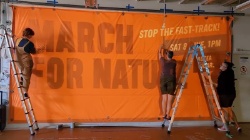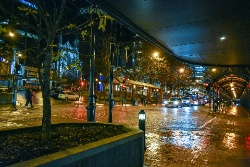CDF Presentation: Details of the training mission to Iraq
[The following is based on automatic text recognition and may contain errors please refer to the original document.
See also: presentation slides]
Address by Lieutenant General Tim Keating, Chief of Defence Force
Details of the training mission to Iraq
24 Feb 15, 2015
(Slide 1 – A Force For New Zealand)
Good afternoon,
A short time ago the Prime Minister spoke to Parliament outlining the decision to commit New Zealand Defence Force personnel to a non-combat training mission.
This Building Partner Capacity mission is in support of the Government of Iraqs request to help counter the threat of Islamic State in Iraq and the Levant (ISIL).
This deployment will help the Iraqi Security Forces build capacity to eventually train themselves.
This afternoon I would like to describe for you how the Defence Force aims to achieve the task set by the Government, by showing who else is part of the Coalition, how the NZDF will undertake this operation, and what this commitment entails.
Before I do that, I want make it clear that as the Chief of Defence Force, and as the principal military advisor to the Government, I have had to satisfy myself as to what we can achieve, and what the risks are of deploying our men and women on this training mission.
In consultation with other senior defence leaders and the wider government security and intelligence community, I have formed the view that this is a mission within the capabilities of the New Zealand Defence Force – and advised the Government of
The New Zealand Defence Force has a long and proud tradition of training and partnering other security forces.
It is a task we are well suited for, and have had many successful results.
From working alongside indigenous tribesmen in Malaya in the 1950s to the ongoing training and mentoring mission in Afghanistan today, our service members have exhibited an aptitude to helping build the capacity of those who have sought our help.
At this point can I say that I wish to present to you a completeas-possible technical explanation of this deployment.
You will also appreciate that there are a number of things which, for operational security reasons, I will not be disclosing.
(Slide 2 – A Coalition Responding)
This slide shows the coalition members contributing some form of assistance against SL.
Note that the number of countries that that have signalled, or provided, some form of assistance is 62 so far.
Of those, about a third have provided a military contribution. We are not alone in supporting the Government of Iraq to counter the threat of ISIL.
Each nation has determined its OWn form of contribution.
The New Zealand Defence Force contribution is that of a non-combat training mission, based at a military complex near Taji.
(Slide 3 – Geographical Context)
This slide shows where Taji is in relation to Baghdad; and the countries that border Iraq.
It shows that Taji is very close to Baghdad; only about 30 kilometres away.
(Slide 4 – Taji Military Complex)
A small scoping team recently travelled to the Taji Military Complex.
From this scoping visit and other information, it has been assessed as a suitable site to conduct a Building Partner Capacity mission.
As the Prime Minister has explained, Taji has now been confirmed as the home of our training contingent, most likely alongside the Australian Defence Force.
The Taji Military Complex will be the principal location of our efforts.
However, a number of staff officers will also deploy to serve in headquarters roles.
Additional logistics personnel will also be required to be deployed to various places in the region to support the deployment to Taji.
This slide shows a satellite view of Taji Military Complex.
This shows it is a very large base that incorporates a military airfield.
What is not shown is the location and layers of Coalition and Iraqi Security Forces, which I will not divulge for operational security reasons.
(Slide 5 – ISIL Location)
At this point it is worth showing where known ISIL locations are, in relation to the Taji Military Complex.
This map shows approximately where ISIL has spread within Iraq.
As to the question of force protection for our personnel at Taji, I will come to that shortly.
(Slide 6 – Operational Approach)
Two weeks ago the Defence Minister authorised the Defence Force to commence formal contingency training for a possible Building Partner Capacity mission to Iraq.
Today I have directed that this training now be deemed pre-deployment training.
This is now the Defence Forces key focus.
| expect the deployment to occur sometime in May, with staff officers taking up their posts next month.
The overall New Zealand Defence Force Commander and Senior National Officer of this deployment will be based in Baghdad.
Although likely to be a joint mission with Australia, as Chief of Defence Force I retain full command of all of our forces, with the Government retaining ultimate decisionmaking authority over the nature and scope of the activities of the New Zealand personnel in the mission.
In terms of training Iraqi Security Forces, this is expected to cover a broad range of individual and organisational military skills.
This includes:
- basic weapons skills; and
- individual and unit military skills to prepare the Iraqi Security Forces for
combat operations.
It also includes the planning of operations, and medical and logistics support to operations.
Training will also be provided to the Iraqi Security Forces so that they can assume responsibility for the delivery of the training programme in the future.
Many commentators have made reference to the time, resources and cost previously committed to training the Iraqi Security Forces.
The principal question raised is: how is the training of the Iraqi Security Forces this time different or transformed from the past if we are expecting a better outcome'
This is a critical question and Id like to address that now.
We, like other Coalition members, have taken the lessons of the past and looked carefully at the needs of Iraqi Security Forces today.
What is apparent is that the Iraqis must be fully integrated into the development and the delivery of training.
That includes working together to assess the objectives of the training, and what the agreed outcomes will be.
True partnership means working together, not a themand-us approach.
It is not just about how our trainers will teach their counter-parts but it is vital for our trainers to better understand how Iraqi soldiers learn.
Though the training programme is yet to be finalised, we would expect to train significant numbers of Iraqi personnel during each training cycle.
This is a substantial contribution to helping build the capacity of the Iraqi Security Forces.
(Slide 7 — Building Relationships)
Success looks like Iraqi Security Force units that the New Zealand Defence Force has helped train being able to commence combat operations, at a trained level as agreed by both the Iraqis and the Coalition trainers.
Success also looks like Iraqi trainers being able to carry on the work of the New Zealand Defence Force and Coalition, thereby creating an independent, selfsustaining capability for the Iraqi Government to call on.
I want to now turn to what this commitment entails, including force protection.
This deployment will see up to 143 personnel deploying to Taji and other parts of the region, with up to 106 in Taji.
(Slide 8 – Force Protection)
A training mission like this is not without risk.
Because of that, a force protection element will be part of the deployment to support the training activities carried out at the base.
All those deploying will be armed and as such will retain the right to self-defence.
But this is not a New Zealand Defence Force training mission to directly confront SL.
It is a mission that is designed to train the Iraqi security forces so that they can better fight ISIL.
This is what the New Zealand Defence Force is preparing to engage in.
The pictures on the slide show some of the physical force protection measures that are typical of such bases in Iraq.
These are physical barriers to penetration of the base.
What the pictures don't illustrate is other force protection elements such as intelligence – like the ability to use modern technology to watch the area around the base.
Coalition forces have considerable abilities in these areas, although I won't be going into details.
However, I can say that our Building Partner Capacity mission will be deployed within an important coalition base, where force protection is a primary consideration.
| can assure New Zealanders that as Chief of Defence Force, everything possible will be done to ensure the safety of our personnel.
(Slide 9 – Message for Families and Friends)
Before we take questions I would like to say something to the families and friends of those who will soon deploy to serve on behalf of New Zealand.
I know that the men and women of our armed forces are consummate professionals, and they have what it takes to succeed.
The Government has made the important decision to deploy New Zealands armed forces to this training mission.
It is our job as a Defence Force to deliver our assignment with commitment, courage and professionalism.
I am confident that our people will — in the finest traditions of our armed forces - do just that.
Thank you.
[original document.
presentation
slides]


 Gordon Campbell: On Why Anti-Zionism Is Not Anti-Semitic
Gordon Campbell: On Why Anti-Zionism Is Not Anti-Semitic Government: New Zealand Supports UN Palestine Resolution
Government: New Zealand Supports UN Palestine Resolution Green Party: Greens Welcome Cross-party Approach To Climate Adaptation
Green Party: Greens Welcome Cross-party Approach To Climate Adaptation Government: Climate Change – Mitigating The Risks And Costs
Government: Climate Change – Mitigating The Risks And Costs Greenpeace: Protest March Against Fast-track Bill Announced For Auckland
Greenpeace: Protest March Against Fast-track Bill Announced For Auckland Wellington Office of the Mayor: Mayor Responds To Housing Minister’s District Plan Decision
Wellington Office of the Mayor: Mayor Responds To Housing Minister’s District Plan Decision Stats NZ: Have Your Say On Modernising The Census
Stats NZ: Have Your Say On Modernising The Census


